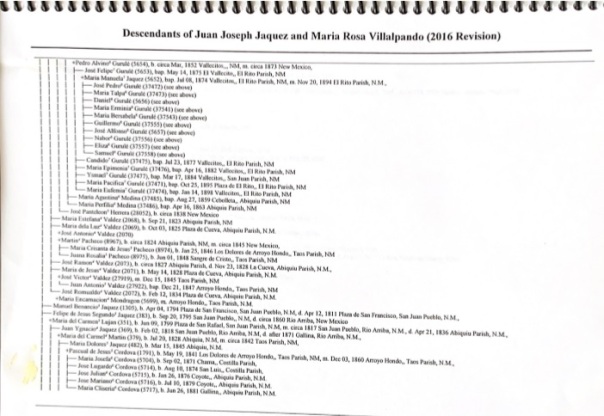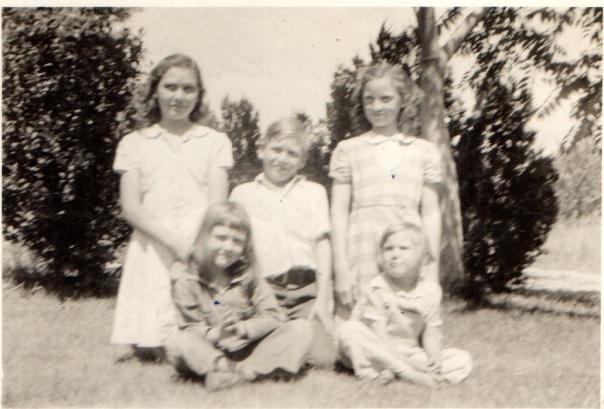So, as we wind our way through and past the Covid-19 Pandemic, we can spend a little bit of time on our ancestors. Their stories are important as we look to how we came to be, how our DNA imprints our lives and how we are connected.
I ordered a magazine by the name of “Herencia” (Heritage in Spanish) and Volume 14 Issue 4 from October of 2006 has a wonderful article about Jose Julian Jaques, the son of Juan Joseph Jaques and Maria Rosa Villalpando. Jose Julian was the child (probably about two) who escaped the brutal attack on the village and was most likely raised by his mother’s family before M.R. was carted off by the Pueblo Indians.
I was given permission from Ronaldo Miera, the President of Herencia, to share this article with you on my blog. This article contains letters regarding J.Julian. How cool is that?
Jose Julian Jacquez was born in approximately 1758 to Maria Rosa Villalpando. I have written extensively about her but haven’t shared the story of Jose Julian. His father was Juan Joseph Jacquez and on August 4, 1760, a Comanche attack occurred at the Villalpando Estancia in Taos Valley, NM. This Estancia comprised of about seven different households and many people were killed in the attack. Over 56 women and children were taken captive, including Maria Rosa. Juan Joseph was killed in the attack but Jose Julian, age two was not harmed nor was he kidnapped. (Truthfully, they probably took all the children they could turn into slaves and he was too young).
With his mother kidnapped and his father dead, we are not positive of his upbringing but can only assume his mother’s family raised him. We know that Pablo Villalpando, Maria Rosa’s reported father, escaped the attack as he was not at home when it occurred. We suppose that her family members that were left raised him.
In 1783, in San Juan Pueblo, Rio Arriba, Jose Julian, now 25 years old, married Maria Paula Martin.
They had 9 children as follows:
Juan Manuel Jaquez 1784
Maria Gertrudis Jaquez 1787
Juan de Jesus Jaquez 1788
Felipe de Jesus Primero Jaquez 1789
Maria Manuela Jaquez 1790
Maria Pacifica Jaquez 1792
Manuel Benancio de los Dolores Jaquez 1794
Felipe de Jesus Segundo Jaquez 1795
Maria Ysabel Jaquez 1797
Maria Paula Martin, wife of Jose Julian, passed away in 1798. Jose Julian remarried in 1798 and had two more daughters.
So now that is the background to Jose Julian’s story. And, just in case you don’t know, Felipe de Jesus Segundo Jaquez is our direct ancestor and the father to Jose Eusequio Jaquez, grandfather to Juan Nepomuceno Jaquez, great grandfather to Celestino Fidencio Jaquez, great-great grandfather to Tim Jaquez and great, great, great grandfather to myself.
Now back to the Herencia article. My favorite thing about this article is that the authors, Patricia Sanchez Rau and Henrietta Martinez Christmas have cited the letters that they found in relation to Jose Julian. Their article does judge Jose Julian but we can discuss that after we look at their article.
The article supposes that in 1802, Jose Julian, in some unknown fashion, is made aware that his mother is still alive and resides in St. Louis. He sets out for Missouri. It was a dangerous time to travel and he could not have left without permission. He must have farmed out his 8 children to relatives and then he left with his second wife and two daughters for Santa Fe where he obtained permission from Governor Nava to go to St. Louis. In 1803, J. Julian has met his mother and half sister, Helene Sale Leroux. He signs a document yeilding his claim against his mother’s estate. For his signature, he was given $200 and the document was witnessed by Jose Ortiz and Francois Valois.
Here is the first article


The article says that “Jose Julian Jacques the amount of 200 pesos in hard currency” in exchange of transfer to his sister Helene his inheritance”.
Jose Julian must not have left St. Louis immediately but eventually made his way back down the Mississippi River to Natchitoches, Louisiana then San Antonio, Monclava, El Paso then Santa Fe. Julian was stopped by the military of Texas and made a declaration of goods to Governor Joaquin Ugarte. The Governor describes Jose Julian’s appearance in this document (the listing of items Jose Julian was carrying with him) and he says that Jose Julian was very dirty in appearance (good lord, in the document it claims that Jose Julian hadn’t bathed or cleaned his clothes in two years!!). This letter is dated March 4, 1804.

Just thinking about this travel/path, on the road, either by boat, horse or walking, and carrying these objects with him. But our Julian doesn’t head right home. For someone who was trying to take these fine belongings to his family, he simply disappears.
After the meeting with Governor Ugarte, he was not heard from for a while. The next document is a letter written in 1809 from Maria Francisca Pacheco looking for information or news about her missing husband Julian Jacques. “Her letter is the sad pleading of an anxious wife to have her husband shipped home.”
The Governor writes back that he has been located and that a Vicente Cruz has loaned Julian 150 pesos to pay his debts so that he can return to New Mexico.
But, as you can see in the next letter, that didn’t happen. Julian goes into hiding again and no way to know where he is during this period. Finally, a warrant for his arrest is put out for his immediate return to New Mexico for his family.
Brigadier General Antonio Cordero indicated that Julian has given a deposition as to his whereabouts.

J. Julian Jacques is finally brought in person in front of Governor Antonio Cordero at San Antonio De Bexar.
J. Julian was very surprised that anyone was looking for him. The actions of the Governor are unknown.
On October 9, 1815, Julian Jacques was escorted by a militia and that Jose Julian has made his way back to New Mexico and to the arms of his loving wife on October 9, 1815.
So there it is. Jose Julian Jacques left to visit his mother in 1802 and returned home to a loving wife in 1815, twelve years later.
I think the saddest thing is Jose Julian dies in 1820, five short years after his return. Did he reunite with his own children, those that he’d abandoned, our ancestor and his siblings?
The very last document listed in this article is the will of Maria Rosa Villalpando.
The writers of this article, Henrietta M. Christmas and Patricia Rau are not related to the Jacques family. But they do have questions posed in the article. The best person to have answered their questions would have been Tommy Martinez. I wish he were still here because i know he would have had an opinion about this article, these letters and the questions posed.
I did ask Henrietta Christmas her thoughts about Julian. She said she thought of him as a “scoundrel” haha. Her thoughts are that he got to see St. Louis and venture out and coming back to sheep and plowing fields wasn’t in his plans. Clearly, his descendants are ages 18-5 when he leaves, not including his second wife and her two daughters. When he returns, all living children are grown, no need for him to parent anyone.
I think of my father as a good father and a good man. I think of Juan N, his grandfather as a good father and a good man. My Grandfather Celestino, may have been a bit more like Julian. Good to some of his children, not great for all of them. This is just my opinion. But, I have to look kindly on Julian, too. He produced 9 children, one of which was Felipe de Jesus Segundo. He married Maria del Carmen Lujan in 1817 in San Juan Pueblo, NM and we have a book that shows his descendants (it was revised in 2016) and compiled by Tommy Martinez. The total number of those descendants listed in his book are approximately 4000 people. Could we be at 5000 now? I’m not sure, but it would not surprise me.

So thank you J. Julian Jacques, for your perseverance and your genes, good and bad.






















